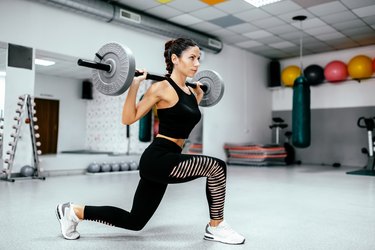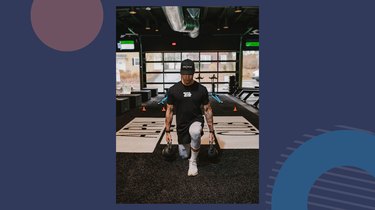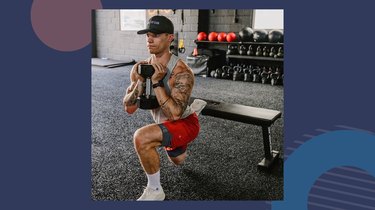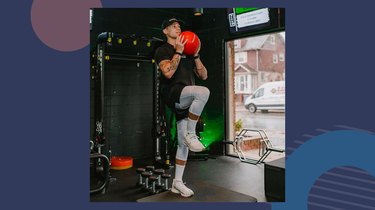
For some, leg day is the most feared day of the week. The popular love-hate relationship with working the lower body stems from the idea that it's pretty hard to work the leg muscles, as they're some of the biggest you've got.
The top highlight of your leg muscles? Your quads — or quadriceps. Bigger quads mean more than just looking great in a pair of shorts. These power-producing muscles are crucial for exercise performance and everyday life. Think of it this way: Your core is the trunk of your body, and your quads (and legs) are the most important branches.
Video of the Day
Video of the Day
Here, top trainers explain why it's important to have strong quads and break down the best exercises for growing stronger, bigger quads.
What Are the Quadriceps Muscles?
The quads are comprised of four muscles on the front of the thigh: the rectus femoris, vastus lateralis, vastus intermedius and vastus medialis.
The quads primarily work to straighten your knees and flex your hips forward, but they play an important role in everything from walking and running to jumping and squatting, explains Sam Tooley, a certified strength and conditioning specialist and endurance coach based in New Jersey.
"Movements such as cycling, running and jumping all utilize your quads to a great degree," Denzel Allen, a coach based in Mill Valley, California, tells LIVESTRONG.com. "Stronger quads make it easier to propel ourselves through space, including making uphill climbs more manageable," he says.
Related Reading
The Benefits of Strong Quads
Aside from the aesthetic and performance benefits of having strong quads, strengthening below the belt will also help you stave off injury and boost your mobility with age.
You'll prevent knee pain. Knee stability is a key benefit of building the quads, Tooley says. Since the quads are the main muscle group that supports the knee joint, they act as the body's natural knee brace.
You'll stave off injuries. According to a February 2019 study in the Journal of Rheumatology, a lack of quad strength can be a predictor of knee cartilage loss and potential injuries.
Moreover, weak quads can force your body to compensate in ways that can cause pain elsewhere, Tooley says. "If one muscle's dramatically stronger than the rest, we're due for an injury. Strengthening your quads is an important piece to the puzzle."
You'll burn serious calories. Since your quads are larger muscles, you'll also burn more calories when you're working them. That's right: The bigger the muscle group you're working, the more energy that's required. According to July 2017 study in PLOS One, doing lower-body resistance training requires more energy than upper-body exercises.
"If one muscle's dramatically stronger than the rest, we're due for an injury. Strengthening your quads is an important piece to the puzzle."
You'll boost your brainpower. A November 2015 study in Gerontology suggests that there's a link between leg power and your overall brain health. British researchers found that women with stronger leg muscles experienced less decline in cognitive function over the 10-year study period.
You'll move with ease. Having strong quads can help you stay active as you age, according to a March 2011 study in the Journal of Aging Health. Researchers found that overall leg strength is one of the best predictors for good physical function as you get older.
How to Build a Quad Workout for Mass
Before you start cranking out all of the lunges and squats, keep in mind that most of the regular movement you do on a daily basis already works your quad muscles. Going for a walk, bike ride or run recruits your quads, but you'll have to strength train these muscles specifically if you want to gain muscle mass — a process called hypertrophy.
To get bigger quads, Tooley recommends doing at least two leg workouts a week. The American Council on Exercise (ACE) suggests completing 6 to 12 reps at 67 to 85 percent of your one-rep max, which is the heaviest weight you can lift at once for any given exercise.
For example, if you're able to do one heavy back squat at 80 pounds, then you might use two 30-pound dumbbells, 75 percent of your one-rep max, for 8 to 10 reps. The closer you get to 85 percent of your one-rep max, the fewer reps you'll do if your goal is hypertrophy, aka larger muscles.
Tip
Don't know your one-rep max? Select a weight that's challenging to lift for all of your desired number of reps but still allows you to maintain good form throughout the movement.
In order to build bigger quads, you also need to incorporate proper recovery time for your muscles to repair. That's because your muscles grow during rest — not during your workouts. The ACE recommends having one full rest day in between training sessions.
Doing the same workout too often can lead to overuse injuries, according to a December 2018 review in the Journal of Orthopaedic Surgery and Research.
On your off days, don't forget to take the essential time to give your legs the TLC they deserve with stretching or gentle cardio workouts like walking. Tooley recommends foam rolling in particular. "There are only a few stretches that really hit the quads, and while they are effective, nothing beats hitting the foam roller to ensure we can hit the muscle from all angles," he says.
How soon you'll see physical results varies from person to person, but within a few weeks, you should start to see some improvements in muscle definition and size. You will see an aesthetic benefit (read: bigger and more toned legs) from training your quads, but the best indication of solid progress hinges on how you feel over time, Tooley says.
"After a month of consistently hitting them, you should certainly feel the difference," he says. For example, your legs might feel less tired after walking up multiple flights of stairs.
Related Reading
6 of the Best Quad Exercises
Just like your go-to ice cream flavor, everyone has a different preference for their leg-day workout. Allen recommends movements that don't strictly isolate the quads to ensure that they function in accordance with the rest of the body — i.e. choose a lunge over something like a leg raise machine.
The muscles in your legs are all interconnected, which is why it's important to vary your exercises and make sure you target them from different angles, Tooley says. Focusing on just one muscle group can lead to muscle imbalances. This is why some runners and cyclists tend to have strong quads but weak hamstrings.
Below, we offer up six different exercises that help build the quadriceps and other leg muscles. Once you're ready to kick things up a notch, there are a few ways to amp up the difficulty on these movements, including increasing the time under tension — aka, the amount of time a muscle is under strain during an exercise — tempo and resistance.
Let's use a squat as an example. "If you really want to spice it up, you can perform isometric holds by staying at the bottom of the squat longer," Tooley says. "Alternatively, you could modify the tempo to a 2:1 or 3:1 count. Count 2 to 3 seconds on the way down and explode up."
If you increase your load, Tooley cautions against lifting too heavy too fast. Reach for a set of weights that is challenging, yet something that you can use to complete the recommended amount of reps with proper form. "The heavier the weight, the more resistance; the more resistance, the more force necessary to complete the movement," he says.
Move 1: Squat

- Stand with your feet hip-width apart and your hands by your sides.
- Extend your arms out in front of you and slowly bend your knees, pushing your hips back to squat down. Lower your body as if you were sitting back into a chair.
- At the bottom of your squat, your thighs should be parallel to the floor (or go as low as you comfortably can with good form). Your knees should be over your toes, not flaring out to the sides or caving in toward the midline of your body. Keep your gaze straight ahead.
- Pause for a moment at the bottom of your squat. Keep your back straight the entire time and all four corners of your feet anchored firmly to the ground.
- Press through your heels to stand back up and lower your hands by your sides.
Move 2: Alternating Forward Lunge

- Stand with your feet about hip-width apart and your arms by your sides, holding a weight in each hand.
- Take a big step forward with your right leg, about three feet, bending the knee until it forms a 90-degree angle.
- At the same time, bend your left leg to 90 degrees until your knee hovers an inch or two off of the ground. Your heel and toes should be aligned.
- Press into your right heel and use your glutes and hamstrings to stand back up, bringing your right leg back to the starting position. Repeat on the left leg.
Move 3: Split Squat

- Hold a dumbbell with both hands at the center of your chest.
- Stand with your feet together in front of a bench or a corner of your couch and take a big step forward with your right leg. Place your left foot on top of the bench. This is your starting position.
- Bend both knees and allow the knee of the back foot to hover just an inch or two above the ground. Keep your chest up and your core engaged throughout the exercise.
- Straighten your legs to return to the starting position. Repeat on the left leg.
Move 4: Step-Up

- Start standing with your feet together in front of a step or box, holding a heavy medicine ball at the center of your chest. You can also do this exercise with a pair of dumbbells at your sides, palms facing in.
- Step your right foot up onto the platform. Make sure your entire foot is on top of the box — not just your forefoot. Step your left foot up. Fully extend the hips by standing up tall at the top.
- Carefully lower back down by stepping your right foot to the ground and then your left. Repeat by alternating legs.
Move 5: Goblet Squat

- Stand with your feet a little wider than hip-width apart and turned out slightly to the sides.
- Holding the weight with both hands at the center of your chest, push your hips back and lower into a squat. Keep your tailbone pointed toward the ground and your chest elevated by engaging your core.
- Press through all four corners of your feet to stand back up.
Move 6: Curtsy Lunge

- Start by standing with your feet shoulder-width apart and your hands on your hips for stability.
- Take a large step back and across to the right with your left leg, crossing it behind the right leg. Lower into a squat so your right thigh is parallel with the ground and your left knee is hovering an inch or two off of the ground.
- Push off with your left leg to straighten your legs and return to the starting position. Repeat by alternating legs.
Tip
For an added challenge, hold a dumbbell in each hand.
- PLOS One: "Energy cost of isolated resistance exercises across low- to high-intensities"
- Gerontology: "Kicking Back Cognitive Ageing: Leg Power Predicts Cognitive Ageing After Ten Years in Older Female Twins"
- Journal of Aging Health: "Association Between Muscle Mass, Leg Strength, and Fat Mass With Physical Function in Older Adults: Influence of Age and Sex"
- American Council on Exercise: "8 Reasons to Take a Rest Day"
- American Council on Exercise: "How to Select the Right Intensity and Repetitions for Your Clients"
- Journal of Orthopaedic Surgery and Research: "Overuse injuries in sport: a comprehensive overview"
- Journal of Rheumatology: "Quadriceps Weakness and Risk of Knee Cartilage Loss Seen on Magnetic Resonance Imaging in a Population-based Cohort with Knee Pain"